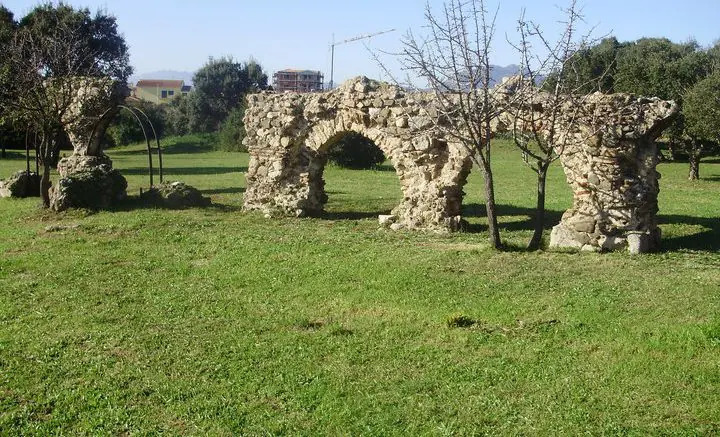Immagina un'epoca antica, dove la sete di progresso si misurava in litri d'acqua. Lontano nelle antiche terre della Mesopotamia e dell'Egitto, i primi ingegneri sperimentavano rudimentali canali per portare la vita attraverso la terra arida. Tuttavia, è nell'epoca dorata di Roma che gli acquedotti si ergono come capolavori ingegneristici senza eguali.
L'Impero Romano, noto per le sue conquiste ma altrettanto per la sua ingegneria avanzata, divenne famoso per gli acquedotti che intrecciavano la terra come vene vitali. Il maestoso Aqua Appia, sorto nel 312 a.C., rappresentava solo l'inizio di un'epoca in cui i Romani padroneggiarono l'arte di condurre l'acqua dalla sua fonte alla sua destinazione.
Imponenti archi e ponti, testimoni della grandezza romana, si ergevano per superare valli e fiumi, mentre gli acquedotti come l'Aqua Claudia e l'Aqua Virgo si snodavano attraverso la campagna, portando vita e prosperità. I Romani, con la loro abilità ingegneristica, garantivano pendenze lievi per un flusso costante, trasformando l'acquedotto in un simbolo di potere e progresso.

Acquedotto romano a Olbia
Ma il crollo dell'Impero portò al declino di queste maestose opere, lasciando spazio a secoli di oblio. Fu solo durante il Rinascimento che l'Europa, risorgendo dall'oscurità, riscoprì l'arte di plasmare la terra per far fluire l'acqua.
Ponte tra antico e moderno, gli acquedotti del Rinascimento riportarono la magnificenza di un'epoca passata. Le città come Parigi e Istanbul, ricche di storia, si arricchirono di nuovi sistemi d'acqua, rimettendo in gioco la corsa per il progresso idraulico.
E così, nel XIX e XX secolo, l'industrializzazione e l'urbanizzazione presero il testimone. Gli acquedotti, simboli di forza e resilienza, si espansero per soddisfare le crescenti esigenze delle metropoli moderne.
In Sardegna, la produzione industriale di acqua imbottigliata diviene una realtà economica importante, rappresentando una ricchezza naturale per la salute e per il palato. Alcuni brand raggiungono una qualità ormai riconosciuta in tutto il mondo.
Oggi, gli acquedotti non sono solo testimonianza di un passato glorioso, ma sono il cuore pulsante delle città moderne. Sotto il suolo, il flusso di acqua continua a narrare la storia di un'umanità assetata di progresso, che ha imparato a plasmare la sua sete in opere grandiose.
ENGLISH
Imagine an ancient era where the thirst for progress was measured in liters of water. Far in the ancient lands of Mesopotamia and Egypt, early engineers experimented with rudimentary channels to bring life to arid landscapes. However, it's in the golden age of Rome that aqueducts rise as unrivaled engineering masterpieces.
The Roman Empire, renowned for its conquests but equally for its advanced engineering, became famous for aqueducts that intertwined the land like vital veins. The majestic Aqua Appia, born in 312 B.C., represented only the beginning of an era in which the Romans mastered the art of guiding water from its source to its destination.
Majestic arches and bridges, witnesses to Roman greatness, stood tall to overcome valleys and rivers, while aqueducts like the Aqua Claudia and Aqua Virgo wound through the countryside, bringing life and prosperity. The Romans, with their engineering prowess, ensured gentle slopes for a constant flow, turning the aqueduct into a symbol of power and progress.
But the collapse of the Empire led to the decline of these majestic works, paving the way for centuries of oblivion. It was only during the Renaissance that Europe, rising from obscurity, rediscovered the art of shaping the land to make water flow.
A bridge between ancient and modern, Renaissance aqueducts brought back the magnificence of a bygone era. Cities like Paris and Istanbul, rich in history, enriched themselves with new water systems, rekindling the race for hydraulic progress.
And so, in the 19th and 20th centuries, industrialization and urbanization took the baton. Aqueducts, symbols of strength and resilience, expanded to meet the growing needs of modern metropolises.
In Sardinia, the industrial production of bottled water becomes an important economic reality, representing a natural wealth for health and the palate. Some brands are reaching a quality that is now recognized throughout the world.
Today, aqueducts are not only a testament to a glorious past but are the pulsating heart of modern cities. Beneath the ground, the flow of water continues to narrate the story of a humanity thirsty for progress, having learned to shape its thirst into grand works.
